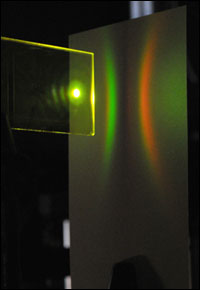
Giving Light 'Amnesia' Boosts Solar Cells
Solar concentrators that rely on mirrors and lenses typically require expensive tracking systems. But another type of cell, a luminescent solar concentrator (LSC) proposed by Argonne National Laboratory and Northwestern University experts, would rely on fluorescent plastic to force light to “forget” its incoming wavelength, making its energy easier to harvest.
“We're actively shifting the frequency of the light by absorbing and re-emitting it,” said Chris Giebink, nanoscientist at Argonne. “LSCs act kind of like flat funnels — we try to absorb a lot of light over the face of a plastic slab filled with dye and then redirect it all back out the edges. The whole process is designed to intensify the light as much as possible.”

A specialized piece of glass called a luminescent solar concentrator can intensify incoming light. The green and orange rings are produced by its fluorescence. (Image: George Joch/Argonne National Laboratory)
The theoretical potential for this intensification, Giebink said, can exceed the equivalent of 100 “suns” — the measurement of solar radiation on one spot. However, actual implementation has until now failed to produce such high intensities. “The main problem we're running into is that light is getting lost in the slabs either due to reabsorption or to scattering, and that's the problem we have to solve,” he said.
Using instrumentation and equipment at Argonne's Center for Nanoscale Materials, the researchers focused on altering the way light is re-emitted and reabsorbed inside an LSC by taking advantage of optical microcavity effects, which occur when the dimensions of a structure are similar to the wavelength of light. In this case, the scientists used a series of thin films with nanometer-scale changes in thickness to produce a resonance-shifting effect, in which light fails to “recognize” the environment that it is emitted from, drastically reducing reabsorption.
“It really is like giving light amnesia — if light forgets how it came in, it's less likely to get reabsorbed or scattered out,” said Argonne nanoscientist Gary Wiederrecht.
Although the Argonne experimental research explored how LSCs work only in one dimension, both Giebink and Wiederrecht believe that a two-dimensional LSC analysis would show even greater efficacy for resonance shifting.
“By finding better and better ways to pull this kind of switcheroo, the higher the efficiency we're going to get,” Giebink said. “We've demonstrated the general principle; now we just have to find the best pattern of dye thicknesses or, alternatively, the best way to vary the thickness of the glass.”
For more information, visit: www.anl.gov
Published: September 2011